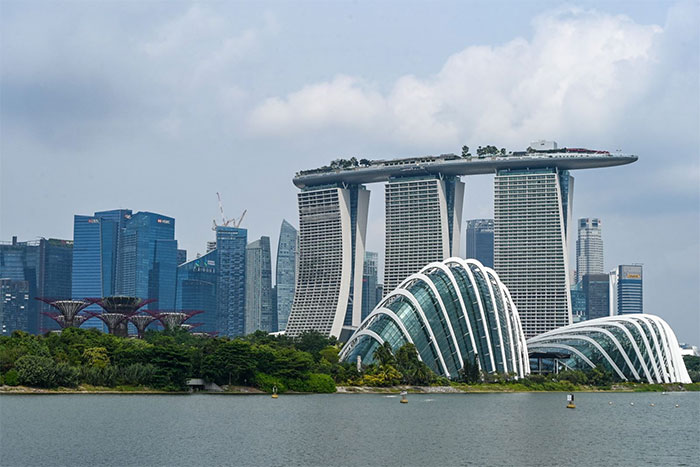How Singapore Solved Its Freshwater Shortage
Singapore, a country with no natural freshwater resources, has succeeded in water management by developing four pillars of water supply and advanced desalination technology.
According to Deutsche Welle International Radio (Germany) on October 1, fresh water is an important resource , affecting the economy and health of the people. Singapore, a small country with a population of about 6 million, is not only a global financial center but also stands out for its innovative solutions in water management. Despite lacking natural fresh water resources, Singapore has turned this challenge into an opportunity, becoming a global model in managing scarce resources .

Singapore is a "master" in rainwater storage and wastewater treatment. (Photo: AFP/VNA).
Singapore has no natural freshwater resources and has been ranked among the most water-stressed countries in the world. From British rule to major wars, water has been a defining factor in the country's development. After gaining independence in 1965, Singapore realized that it had to take its water destiny into its own hands and developed a comprehensive water management plan.
Singapore has developed four pillars of water supply known as the 'National Taps' : imported water, desalinated water, local water storage and recycled water (NEWater). To secure water supplies, the country has entered into agreements with Malaysia, which supplies half of Singapore's total water needs. However, tensions between the two countries over water supply have increased, with Singapore expected to stop importing water by 2061. This has prompted Singapore to focus on the remaining three 'taps' and improve efficiency.
Jon Marco Church, a water management expert at the United Nations, stresses that master planning for water is important: 'The goal of this planning is to make the most of every drop of water.' To do this , Singapore has invested billions of dollars in water collection and treatment infrastructure , ensuring that its canals and drains are kept clean.
Today, Singapore has five desalination plants, which provide 25% of the island nation's total water supply. These plants not only function as water purification facilities, but are also designed to be modern and integrated into the city's landscape. Singapore's goal is to increase its desalination capacity to meet 30% of its water needs by 2060. However, as there are many other factors that affect self-sufficiency, importing water from other countries remains an indispensable part.
In addition, Singapore has used two-thirds of its land area to collect rainwater. Rooftop water is channeled through pipes/drains into a network of rivers, canals and reservoirs. The Marina Barrage, covering 10,000 hectares, not only collects fresh water but also acts as a flood protection structure. The Singapore government plans to use 90% of the country's land area to collect rainwater by 2060.
In addition to infrastructure measures, Singapore has focused on raising public awareness about water issues. Subsidizing water-saving appliances and developing technology applications that help people save water have become important steps in this strategy.
Singapore is not only a master at collecting rainwater, but also excels at treating wastewater. At a cost of up to $10 billion, the island nation has built a modern, centralized wastewater treatment system and efficiently reused wastewater. "All wastewater is collected, treated and reused as much as possible," said Jon Church of UN Water. Singapore currently recycles 30% of its water needs, with plans to increase this to 55% by 2060.
Singapore's water recycling technology has reached a high level , with water obtained through microfiltration, reverse osmosis and UV radiation processes. This recycled water is not only used for domestic needs but also in industries that require clean water such as chip manufacturing.
Singapore is a shining example of how a country can turn challenges into opportunities through effective water management policies. With a long-term vision and massive investments in infrastructure and technology, Singapore has not only met the water needs of its citizens but also contributed to sustainable development for the future. Singapore's story is not just about water, but also about how a country can adapt, innovate and thrive even in the most challenging conditions.
- Singapore inaugurated the first water park
- Solve global shortage of freshwater
- Science dreams
- Discovered a giant freshwater lake located underground, up to 2,800 km3 in volume
- Singapore: From polluted 'paradise' to the world's leading clean country
- Chinese desert freshwater lake gradually disappears
- Singapore: Journey from quagmire to Asian dragon
- 10 special things 'coffin' Singapore that tourists will look stupid when they come here
- Discovered 7 new leech species living in freshwater mussels
- Migratory freshwater fish populations have declined by more than 80% since 1970
- Interesting facts about Singapore
- Summary of popular freshwater fish species in Vietnam you should know
 'Barefoot engineer' invents a pipeless pump
'Barefoot engineer' invents a pipeless pump Process of handling dead pigs due to disease
Process of handling dead pigs due to disease Radiometer
Radiometer Warp Engine: Technology brings us closer to the speed of light
Warp Engine: Technology brings us closer to the speed of light